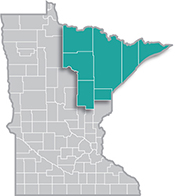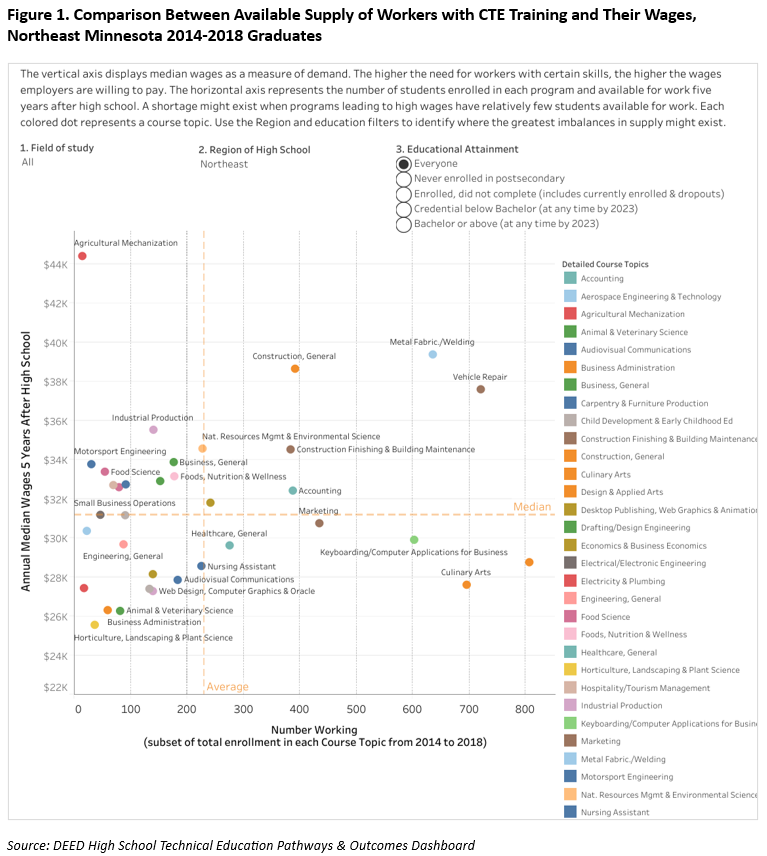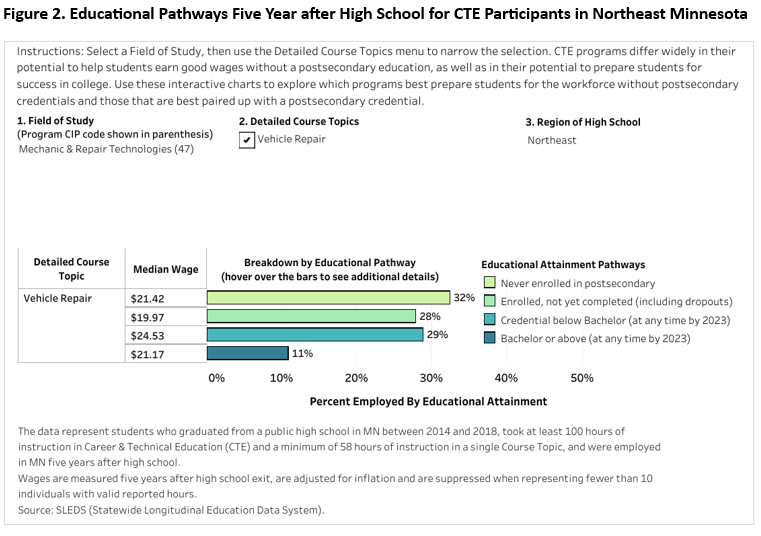 Home to the state's second-largest metro, the Northeast Region has a strong industrial sector, tied largely to the area's abundant natural resources.
Home to the state's second-largest metro, the Northeast Region has a strong industrial sector, tied largely to the area's abundant natural resources.
Most of the manufacturing base centers on mining and forest products industries. More than half of the sector's employment is in paper and machinery manufacturing.
Want the freshest data delivered by email? Subscribe to our regional newsletters.
2/19/2025 2:33:24 PM
Carson Gorecki
I recently was lucky enough to participate in a tour of the Career & Technical Education (CTE) classes and facilities in Duluth Public Schools. On that tour we were shown how the understanding of CTE has evolved from what used to be a limited selection of Industrial Technology and Family and Consumer Science classes to a much broader array of subjects and skills that are much more intentionally linked with local career opportunities. There are now over 50 different CTE course topics.
These classes are aimed at better preparing our young people for life - and careers - after high school. According to the Minnesota Department of Education, CTE programs are intended to "help to connect students with high-skill, high-demand science, technology, engineering and math fields…". Connections are strengthened through experiential and work-based learning that emphasizes directly applicable and practicable skills, knowledge, and credentials. This endeavor is driven and informed by the federal Strengthening Career and Technical Education for the 21st Century Act, also known as Perkins V.
With the increasing popularity of CTE programs in Minnesota High Schools, the release of a new dashboard detailing outcomes and pathways of CTE students is especially timely. Created by our excellent researcher Alessia Leibert, the /deed/data/data-tools/cte-pathways/index.jspHigh School Technical Education Pathways & Outcomes dashboard answers four top questions, breaking out the answers by course topic, region, and more. I encourage you to read /deed/newscenter/publications/trends/december-2024/cte.jspAlessia's article explaining and summarizing the data and the tool. Here are some examples for our region, Northeast Minnesota:
I begin with what is Figure 4 in the dashboard. This chart compares wages 5 years post high school graduation for 2014-2018 graduates in Northeast Minnesota. Metal Fabrication/Welding and Vehicle Repair had relatively high numbers of participants and paid wages above the regional median for all regional CTE participants (see Figure 1). Participants in Keyboarding/Computer Applications for Business, Culinary Arts, Design and Applied Arts also had over 600 students working five years post-graduation, but paid out wages below the regional median. This shows that these CTE programs are popular but may not be translating to as high of wages as other programs offered. Others such as Agricultural Mechanization may be relatively small in that they end up having relatively few participants employed post-graduation, but pay high wages for those that are.

One reason for these patterns may lie in the occupations and industries that the CTE programs are most closely associated with, and additionally, which postsecondary pathways may be required or most likely. Taking Vehicle Repair as an example, only 11% of graduates that participated in that topic ended up pursuing a bachelor's or advanced degree by 2023 (see Figure 2). By contrast, roughly equal shares never enrolled in postsecondary, enrolled but didn't complete, or attained a credential below a Bachelor's. The richness of these data also allows us to compare wage outcomes by chosen educational pathway. The 11% of Vehicle Repair participants that did pursue Bachelor's degrees had lower wages than those that opted for a lower credential or choose not to pursue postsecondary education at all. For these graduates, it appears that a more direct route to a career in Vehicle Repair may be more rewarding in terms of wages.

That a student participated in a given CTE program or topic is not a guarantee that they will end up employed in a related field. In fact, many students participate in several topics while in high school. However, some programs appear more tightly linked to certain industries. Continuing with the Vehicle Repair example, 37% of students that participated in that topic ended up employed in either the Construction or Manufacturing sectors (see Figure 3). That was a tighter link than most CTE topics or programs had with industries, and it was even stronger for those high school graduates that did not pursue postsecondary education. Among those students, 29% ended up in Construction and 17% in Manufacturing, summing to 46%. This makes some sense when you look at the wages. Other than the relatively small combined Agriculture, Mining, and Utilities sectors, which paid a whopping median wage of almost $40 an hour, Construction provided the next-highest wages for Vehicle Repair participants.

This tool provides valuable insight into the pathways available and chosen by actual participants in Career and Technical Education programs in Minnesota. Career and Technical Education is intended to prepare our high school students more directly to enter the workforce. Workforce and Education stakeholders at the local level now have an opportunity to compare and assess outcomes, but also zoom out to see how our region is doing in connecting students with well-paying careers. Dig in and enjoy!
Contact Carson Gorecki at carson.gorecki@state.mn.us.